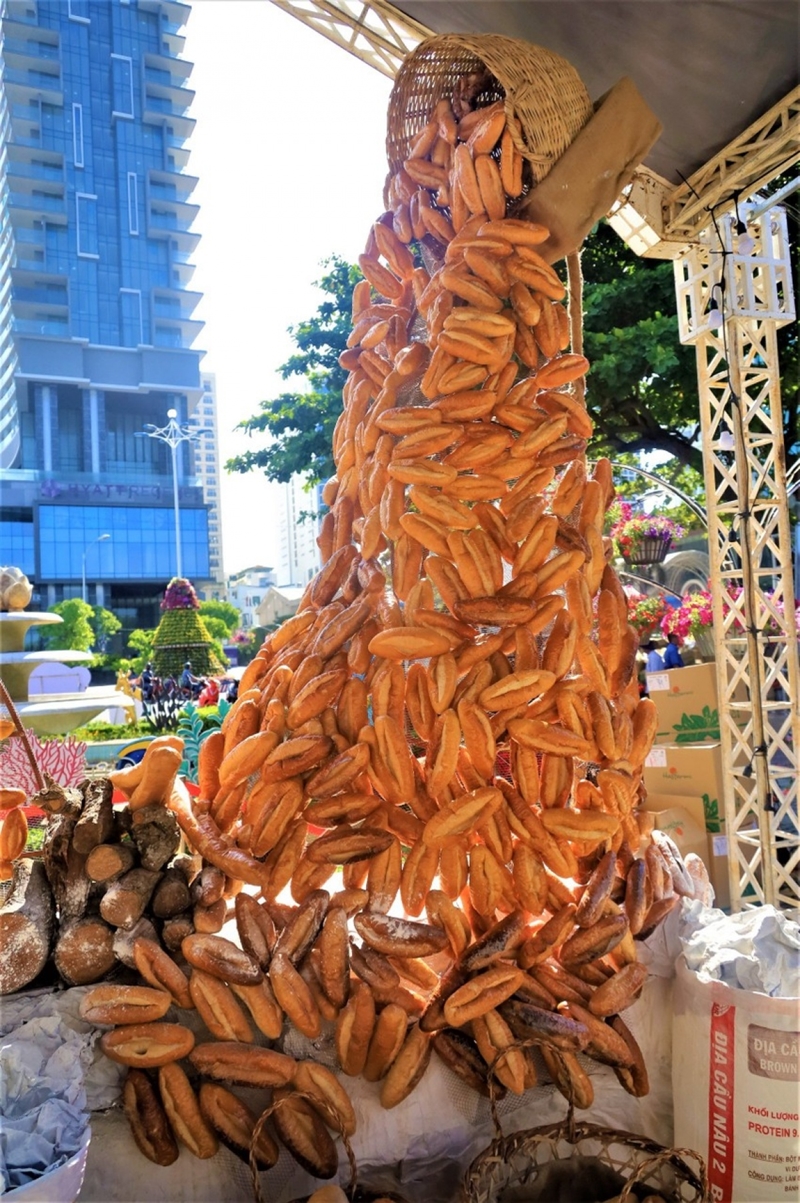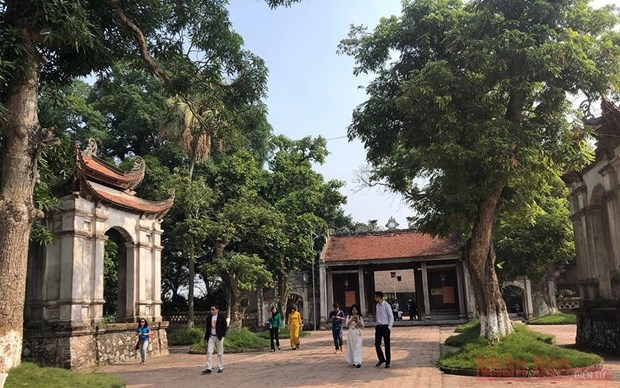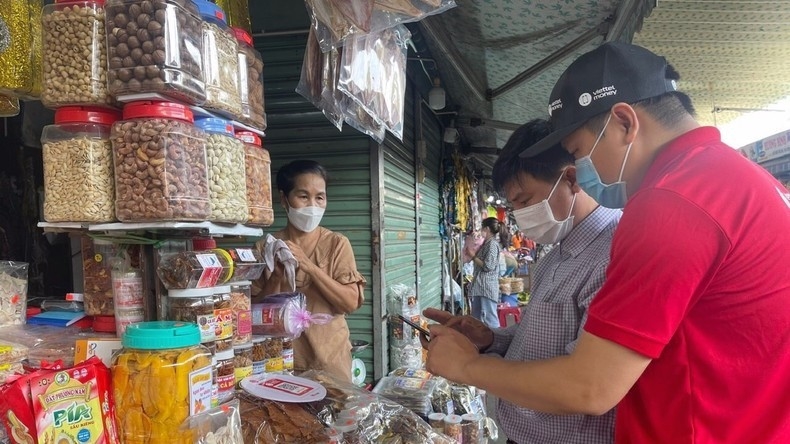 |
| Spectrum of the Seas, Asia's largest luxury cruise ship docks the Cai Mep-Thi Vai port in Ba Ria-Vung Tau province on August 22. (Photo: plo.vn) |
According to Vietnam News Agency, Spectrum of the Seas, Asia's largest luxury cruise ship, docked at Nha Trang port on August 21, marking its visit for the second time in a month.
In the first half of this year, Khanh Hoa received over 2.7 million visitors, about 70% of this year’s target.
Wu Huimin, captain of Royal Caribbean's Spectrum of the Seas, said that when the cruise docked at Tokyo port to pick up Japanese tourists, they were looking forward to coming to Vietnam because of the country’s beautiful scenes and friendly people.
The captain said that during the 12-day journey, about 4,300 guests on the cruise will explore Asia's top destinations including Nha Trang city and Ba Ria-Vung Tau province in Vietnam, Tokyo, Kumamoto, and Kagoshima in Japan, Hong Kong (China), and Singapore.
Angie Stephen, CEO of Royal Caribbean International Asia-Pacific, said that the company owns the world's leading fleet with 226 cruises. Two of its cruises will soon return to Vietnam, and expectedly bring tourists to Hue city, Nha Trang city, and Ba Ria-Vung Tau province.
The official said that at the docks, cruise passengers are interested in experiencing local culture, visiting craft villages, shopping, and enjoying local food, which will bring economic benefits to Vietnam's tourism industry.
Tran Thi Thu Hien, Deputy Director of the Department of Tourism of Ba Ria-Vung Tau province, said that cruises create opportunities for the province to promote its image and boost tourism.
Hien said that with the local Cai Mep - Thi Vai deep-water port, the province has over the recent past welcomed three large cruises, which shows that cruise travel has returned to normal.
She said the province is developing a specific tourism promotion plan for international cruises
At the Seatrade Cruise Asia Pacific slated to take place in Hong Kong in October, the province will connect with the world’s leading cruise firms to attract more international visitors.
Nguyen Quy Phuong, head of tourism promotion management department under the Vietnam National Authority of Tourism, said that there are 15-16 million cruise tourists in the world each year. Although the number of the tourists in this group is not large, this is a segment with high spending and long stays.
Largest model of bread tower in Vietnam recognised
The Khanh Hoa Culinary Culture Association received a national record certificate on August 23 for having the largest bread tower model in Vietnam, reported the Voice of Vietnam.
 |
| A bread tower model created during the Nha Trang - Khanh Hoa Sea Festival 2023 set a record for being the largest in the country. (Photo: Plo.vn) |
The model was created on June 5 by culinary artist Hoang Thi Anh Tuyet of the HTCHEF Vocational Training School in celebration of the Nha Trang - Khanh Hoa Sea Festival 2023.
The 3.2-m high and 6-m long bread tower was made up of more than 800 loaves of thick bread with sizes of 60cm and 10cm each.
The loaves of bread were made by Pham Dinh Tien who has more than 40 years of experience in making bread in Nha Trang.
The Vietnam Records Organization (Vietkings) announced that the piece set a record for being the largest bread tower model in the country.
Bánh mì (bread) in Nha Trang is a daily favourite dish because of its unique taste not only among tourists, but even locals. It boasts a crispy, stretchy, dense, non-fatty, and buttery crust that has the natural aroma of flour.
Arriving in Nha Trang, visitors can encounter bread stalls on major roads or in small alleys. The dish is sometimes sold in spacious, well-invested shops or found in just simple small bread cabinets by the roadside.
Hung Yen steps up rural tourism development
Over the recent years, many localities in the northern province of Hung Yen have been actively developing rural tourism with a focus on promoting trade-investment linked to harnessing the potential and advantages of local agriculture, craft villages, culture, and the ecological environment, reported Vietnam News Agency.
 |
| Tourists at the Chu Dong Tu temple in Hung Yen. (Photo: baohungyen.vn) |
Through the ups and downs of time, the land and its people still keep intact communal and ancient houses as well as the customs and traditions deeply rooted in Vietnamese culture.
In Hung Yen, rural tourism primarily involves visiting craft villages and exploring historical and cultural relics, festivals, and more. Recently, some areas in the province have introduced models that combine farms with tourism, enabling visitors to sightsee and purchase farm produce. Notable examples include flower and ornamental tree villages in Xuan Quan, Phung Cong, Me So communes, Van Giang district; the Nam Nghia Trai medicinal herb village in Tan Quang commune, Van Lam district; and the Hong Nam longan cooperative in Hung Yen city, among other locations.
Tat Vien village in Thu Sy commune, Tien Lu district, is renowned for its traditional fish trap weaving craft that dates back over 200 years. Visitors not only learn about the process of making fish traps but also experience firsthand the art of weaving, creating their own products. They can also role-play as farmers, bringing their products to the fields to acquire skills in catching shrimp, crab, and fish.
Currently, many tourists favour the agro-tourism model thanks to its cost-effectiveness. For a weekend, Nguyen Le Hang from Luong Bang town, Kim Dong district, brought her children to visit and experience grape-picking at the Hong Nam Green Agriculture Investment and Development Cooperative in Bao Khe commune, Hung Yen city. She said this is not just a simple outing, but also a way for the kids to learn through practical experience, getting close to nature, and thus gaining a better understanding of the lives of farmers. “It teaches them to appreciate labour,” Hang said.
However, when looking at the overall picture of the sector in the province, it's only available in a few locations with standalone, locally-developed services. These services lack comprehensive linkage to form a quality service chain that meets tourists' needs, hence limited revenue.
Pham Van Hieu, Deputy Director of the provincial Department of Culture, Sports, and Tourism, noted that in its overall tourism development plan until 2025, with a vision to 2030, the province aims to create a system of high-quality, distinctive products with high value added, which caters to tourists' demands. The focus is on developing green products, particularly involving rural and community-based tourism, as well as eco-tourism.
To reach the goals, the province needs to prioritise resource allocation for organising tourist sites and areas, and harmonising infrastructure and improving facilities to serve the industry. It is necessary to construct exhibition centres and outlets to showcase and sell agricultural, traditional craft products, and souvenirs of high quality; pay attention to human resource training; and connect tour routes and attractions within the province.
Concurrently with exploitation, the province needs appropriate policies to conserve and promote cultural spaces and historical relics, and to support the preservation, restoration, and development of traditional craft villages. This can contribute to enhancing the living standards of residents and achieving a sustainable shift in the local rural economic structure.
Da Nang forms many cashless streets
One of the efforts by Da Nang City’s government to facilitate locals and visitors in non-cash transactions is to promote the digital transformation of the tourism industry. Online payment by scanning QR codes and the use of e-wallets at many tourist streets and markets have brought convenience to people and visitors.
 |
| Tourists scan a QR code for payment at the Vietnam-Da Nang International Food Festival 2023. |
Recently, An Thuong pedestrian street and night market in My An Ward, Ngu Hanh Son District, has utilised online payments by scanning QR codes and using e-wallets. This is a street with a large number of foreign tourists staying, travelling and experiencing food. Many food and beverage shop owners on the street said that the non-cash payment has created a new and modern look for the street in the eyes of tourists, especially foreigners.
Dang Thi Ni Na, owner of a restaurant on the street, said her restaurant has used online payments for a long time. About 80% of shoppers scan QR codes for payment. “As a street welcoming a large number of foreign visitors, the non-cash payment is very convenient and safe”, added Ni Na.
Travelling and enjoying food at An Thuong night market, Robert, a British tourist, and his family were very pleased with scanning QR codes for payment.
Bach Ngoc Hai, Chairman of My An Ward People’s Committee, said that the urban infrastructure of An Thuong Street has been upgraded to serve tourism. The application of online payment aims to create favourable conditions for tourists and modernise services in tourism. Currently, the street has more than 150 business households. Previously, the ward had propagated and encouraged people to effectively implement the cashless street model. The locality is continuing to improve this model to soon achieve the goal of 100% of business establishments in An Thuong Street providing non-cash payments.
In Hoa Vang District, Tuy Loan night street was established and put into operation by the end of 2020, with 100 stalls providing diversified products, aiming to become a new tourist product in the western part of the city. According to the Management Board of Tuy Loan Market, currently, 250 out of 570 business households in the market have bank accounts and use smartphones and Internet banking for non-cash payment transactions. The market management board is continuing to promote the coordination in installing the apps for the remaining small traders.
At the end of July 2023, the Hoa Vang District People's Committee launched the model of a "Cashless payment market" at Tuy Loan Market and signed the implementation agreements in 11 communes. Hoa Vang District has provided investment in a free fibre optic internet system at Tuy Loan Market, with seven high-speed wifi lines, contributing to promoting non-cash payment activities at the market, including e-payment between small business households and people, in a convenient and fast manner.
Standing Vice Chairman of Hoa Vang District People's Committee Nguyen Thuc Dung said, that the launch of the “cashless payment market” model and the signing of contracts for the implementation of this model in the communes, is an activity that creates a strong transformation and encourages people to use non-cash payment methods, contributing to speeding up the process of developing and implementing a digital transformation plan in the district, towards giving people a better experience of a modern payment method, with the motto of “Cashless: one change, thousands of good things”.
In January 2023, Da Nang City People’s Committee issued a document requesting departments, agencies, agencies, units, and People's Committees of districts to speed up the implementation of Decision No. 1813/QD-TTg, on approval of a project on developing non-cash payment in Vietnam for the 2021-2025 period. Accordingly, the City People's Committee requires departments, agencies, People's Committees of districts and public service providers to strengthen propaganda among people to use non-cash methods in payments for public services, taxes and insurance.
 |
| Small traders in the markets around the City have deployed the Market 4.0 application, so that customers do not need to use cash. |
Implementing this policy, the Da Nang City Department of Tourism has issued a plan to implement the “project on the development of non-cash payment in the tourism industry during the 2023-2025 period”. Da Nang’s tourism industry set a target, that by 2025, 100% of tourism service businesses in the city will disseminate the State's guidelines and policies on non-cash payment and 100% of tourism service businesses will apply one or more non-cash payment methods, such as scanning QR code, VNpay, card swipe by POS machines, Internet banking, Mobile banking and direct transfer from ATMs. In addition, service beaches and tourist service business households in areas under the management of the Son Tra Peninsula Management Board and tourist beaches around the city will make use of non-use payment means, to become a habit of people and tourists.
Da Nang has cooperated with the Military-run telecommunications group Viettel, the Vietnam E-commerce Association and companion units such as Mobile Service Joint Stock Company (Momo wallet) and local banks, to implement the cashless street project. Up to now, Da Nang has been implementing the "Market 4.0" model in several large markets including Han, Con and Dong Da Markets, as well as encouraging small traders and consumers to apply non-cash payment methods.
In 2023, Da Nang actively developed many cashless payment streets in the central areas such as Nguyen Van Linh, Tran Van Tru and Nguyen Huu Tho Streets, Huynh Thuc Khang Street specialising in breakfast, An Thuong pedestrian street, and Tuy Loan Market.
The simultaneous formation of many cashless streets in Da Nang City aims to satisfy residents and visitors in the process of digital transformation and building a smart city. These are solid foundations for Da Nang's tourism industry to realise its digital economic goals./.